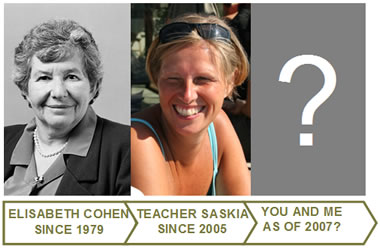Have you ever tried to find a definition of teamwork in management literature? I have; and I was overwhelmed, confused, over buzzed and totally blown away with all that expensive talk. However, none of it made sense.
Until a few years ago, teacher Saskia, whom I grew up with, told me about Complex Instruction (here in Flanders, where we live, it is locally referred to as CLIM). I was surprised about the straightforwardness of the concept and the first reaction that came to my mind was: ‘why didn’t they use that when we were young?’
In a nutshell, Complex Instruction (CI) is a cooperative learning method that stimulates social skills such as collaborating, communicating and taking responsibility. In her research, Elisabeth Cohen – one of the founders of CI, discovered that it is an effective way of reaching cognitive goals. In other words: her research showed that interaction facilitates learning.
One of the fundaments of CI is the assignment of roles which only deliver an optimal result when they fully cooperate. The premise here is that everybody is good at something and nobody is an expert at everything. So the design of CI classes and seminars is such that participants can only reach the best result if they stick to their role and fully cooperate. Following skills are explicitly addressed: listening, discussing, deciding; like for example in the 4-stage rocket preparation exercise.

Over here, in a school in the town of Grimbergen, teacher Saskia is successfully using CI with her 9 year old students for more than three years. She equals at least the intellectual results of the traditional teaching methods. But there is more: by the time her students turn 10, they have improved their skills to listen, cooperate and interact. I would say that’s pretty fundamental.
Like me, you may wonder: ‘if this thing works with 9 year olds, it can’t be that difficult with adult working professionals’. … well … About one month ago we installed a mechanism of 176 parallel workshops in a big project that needs to be run over the course of a few months. In order to get the team of 50 professional consultants to work with a uniform approach, we chose the CI roles and setup to get started.
It was obvious that these workshops can only deliver results if all of these professionals AND the more than 150 customers involved fully engage in these workshops, i.e.: listening, cooperating and interacting. I have to say that it takes thorough coaching on the following dimensions:
– Nearly all professional consultants see themselves as a facilitator (which blocks interaction, whilst ignoring the other essential roles)
– None of the professional consultants see themselves as a materials responsible (which results in missing chairs, beamers, keys, frustrated customers, wasted time, etc.)
– Listening and repeating back in a roundtable conclusion is seen by most as ridiculous (so all the points of view that were not listened to end up in the grapevine circuit and create complaints from a higher hierarchical level)
Phew! I have to say that CI with adult professionals is harder than I thought it would be. But the blocking factors are too fascinating to just let go of the concept: they are not based on CI as such, but rather on professional adult people taking themselves too serious to focus explicitly on listening, cooperating and interacting. In short, we may end up by redefining the hard-wired definition of taking responsibility. Anyway, I hope I will not be the only nutcase management consultant implementing CI with adults. The results are positive and the reactions of the adults are fascinating. So if you read this, please give it a go and share your experiences!
Click here for more materials to get started in CI.
Click here to link to Elisabeth Cohen’s basic book on CI.

